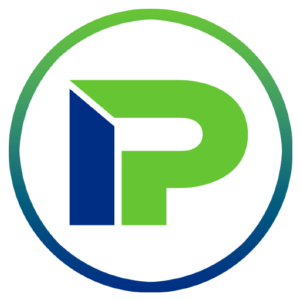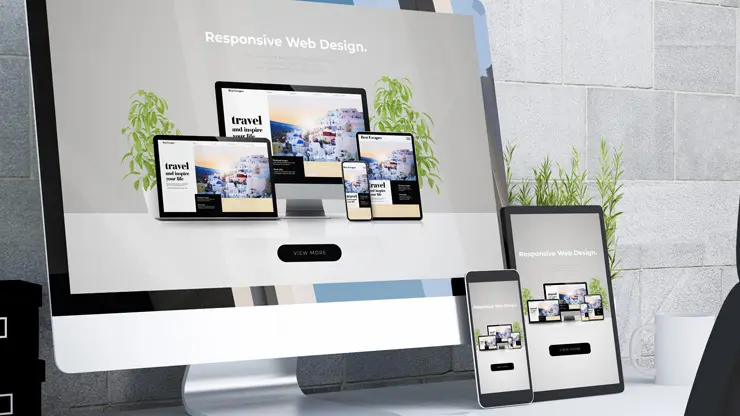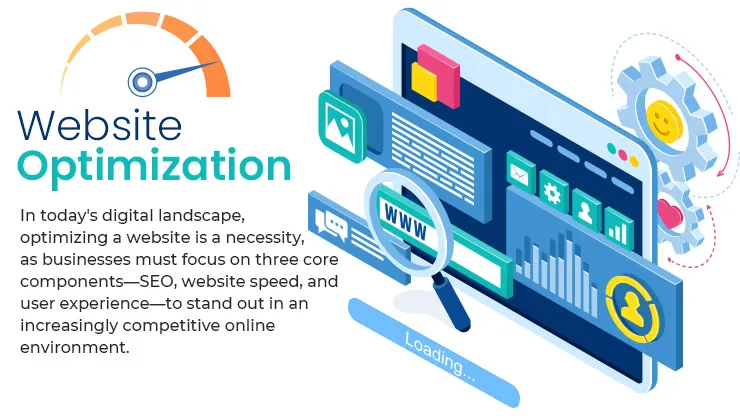In the online era of business, web design has become increasingly vital for companies of all kinds. Whether you’re creating a new website for your freshly-founded business or updating an outdated one as part of a rebrand, almost all companies will need to dive into the specifics of building a functional and aesthetically pleasing website.
While there are numerous DIY website builders available for the average person to create their own site, these platforms often lack the flexibility and customization needed for a truly professional web presence. This is where hiring a professional web designer in Tallahassee becomes indispensable.
But what does it really cost to get a website custom-built and equipped with all the necessary features including security components? Typically, web designers charge around $75 per hour. The overall cost for a small business website can range between $5,000 and $10,000, with the average being approximately $6,760 for setup, design, and ongoing content creation.
Understanding these typical costs is crucial whether you’re looking to hire a web designer for your business. This guide will provide comprehensive insights into web design pricing, covering various factors that influence costs, average pricing models, and a detailed cost breakdown.
Let’s delve into the intricacies of how much web designers really charge and what you should consider when budgeting for your next web design project.
Introduction to Web Design Costs
A well-designed website is not a luxury but a necessity for businesses of all sizes. Whether launching a new venture or revitalizing an existing online presence, understanding the costs involved in web design is crucial. As previously mentioned, while DIY website builders promise easy setups, they rarely offer the flexibility and professional touch that a tailored website from a skilled web designer in Tallahassee can provide. Before diving into the specifics, it’s important to recognize that the cost of web design is influenced by several factors and can fluctuate significantly. On average, web designers charge around $75 per hour, but the total cost for a comprehensive site can range from $5,000 to $10,000. The average cost hovers around $6,760, which includes initial setup, design, and ongoing content creation. This guide will break down these expenses, providing a clear picture of what you might expect to pay while highlighting the key factors that influence these costs.
Factors Influencing Web Design Costs
The cost of web design varies widely based on several key factors. Understanding these factors is essential for both clients seeking web design services and designers setting their rates. Let’s break down the primary elements that influence web design costs:
Experience and Skill Level
The experience and skill level of a web designer substantially affect the overall cost of web design services. Designers who have accumulated years of experience and possess a robust portfolio typically command higher rates. Their advanced expertise allows them to handle complex projects, ensuring the final product is both aesthetically pleasing and highly functional.
A seasoned web designer brings a wealth of knowledge, including the latest design trends, coding standards, and user experience principles, which together contribute to a superior website. On the other hand, newer designers, still in the process of building their reputation and portfolios, may offer lower rates, making them a more budget-friendly option for clients willing to trade off some experience for cost savings.
When hiring or setting your rates, it’s crucial to consider how much expertise and historical success the designer can bring to the project, as these elements directly influence the quality and efficiency of the website’s creation.
Project Complexity
The complexity of a web design project is a crucial determinant of its overall cost. Simple, minimal websites that serve purely informational purposes are generally less time-consuming and therefore less expensive to create. These sites often comprise a few pages with straightforward navigation and basic design elements.
In contrast, more complex websites demand extensive time and effort, driving up the costs significantly. For instance, e-commerce platforms, membership sites, or websites requiring user account functionalities necessitate advanced coding, robust security measures, and integration with multiple third-party services. These features entail rigorous planning, designing, and testing, thereby increasing the total cost.
Additional factors contributing to project complexity include the necessity for custom graphics, unique design layouts, and specialized user interactions, such as animations or interactive maps. Each element adds layers of intricacy that require skilled web designers and developers to execute seamlessly. For this reason, fully custom websites can range from $5,000 to upwards of $10,000, reflecting the comprehensive expertise required to meet these advanced needs.
Market Rates
The prevailing market rates significantly influence what web designers charge for their services. These rates can vary depending on geographic location, industry niche, and current demand for web design services. For instance, designers working in metropolitan areas or those specializing in high-demand sectors often command higher fees. The cost of living in different regions also plays a crucial role, with designers in urban centers typically charging more to compensate for higher living expenses.
Additionally, market rates are influenced by the competitive landscape. Web designers must balance competitive prices with fair compensation for their expertise and the quality of their work. This involves keeping up with industry standards, monitoring the rates charged by peers, and understanding client expectations. By staying informed about prevailing market rates, designers can set their prices confidently, ensuring they remain competitive while delivering valuable services to their clients.
Average Web Design Pricing Models
Web design pricing models generally fall into two primary categories: hourly rates and flat fees per project. Both models have their advantages and can be suitable depending on the nature of the project and the preferences of the client and designer. Understanding these models is essential for making informed decisions when budgeting for web design services or setting your rates as a designer.
Hourly Rates
Charging hourly is a common practice in the web design industry. This model allows flexibility, enabling clients to pay only for the time spent on their project. As previously mentioned, typically web designers charge around $75 per hour, although this can vary widely based on experience, skill level, and geographic location.
For instance, while some designers may charge as low as $30 per hour, others, particularly those with specialized skills or extensive portfolios, may command upwards of $100 to $180 per hour. This model is beneficial for projects where the scope might change, as it ensures designers are compensated for all the time dedicated to the project.
Flat Fee Per Project
The flat fee pricing model offers transparency and simplicity, allowing clients to know the total cost upfront. This is particularly appealing to clients who want to avoid unexpected expenses and have a definitive project outcome. However, it requires accurate estimation of the project’s scope to ensure fair compensation for the designer. Flat fees for web design projects can range significantly, from $500 for a simple one-page site to $10,000 or more for complex, custom websites with advanced functionalities. This model encourages thorough planning and clear agreements on project deliverables, timelines, and revisions.
Understanding these pricing models is crucial for both clients and designers. Clients should consider their project requirements and budget, while designers need to evaluate their time, expertise, and market conditions to decide on the most appropriate pricing strategy. By comprehensively assessing these factors, both parties can ensure a mutually beneficial working relationship.
Detailed Cost Breakdown for Web Design Services
When budgeting for web design, it’s essential to understand the various components that contribute to the overall cost. Each element can vary depending on the project’s requirements and the designer’s expertise.
Below is a detailed breakdown of the typical costs associated with web design services:
Setup Costs
Setting up a website involves initial steps like domain registration, hosting setup, and basic configuration. These setup costs can range from as low as $50 to as high as $200, depending on the domain cost and chosen hosting plan. Factors such as the hosting provider’s quality, the domain’s popularity, and additional services like SSL certificates and security features also play a role in the setup expense.
Custom Website Design Costs
The heart of web design lies in creating a custom website tailored to a client’s specific needs. Custom designs offer unique layouts, branding elements, and user interface designs that distinguish a website from generic templates.
Prices for custom website designs typically start at $5,000 and can go up to $10,000 or more for intricate projects with numerous unique features. The complexity of functionalities, such as e-commerce capabilities, member logins, or interactive elements, significantly influences this cost.
Content Creation Costs
Content is integral to a website’s success, requiring text, images, videos, and graphics.
The cost of content creation varies widely, ranging from $500 to $5,000. Factors affecting this include the amount of content needed, the frequency of updates, and the type of content created.
High-quality, professionally written articles, custom graphics, and engaging videos typically command higher rates, reflecting the skill and time investment required.
Maintenance Costs
Ongoing website maintenance is crucial for keeping your website secure, updated, and running smoothly. This involves regular updates to the website’s software, security checks, backups, and addressing any technical issues that may arise. Annual maintenance costs generally fall between $500 and $1,000. These costs ensure that the website remains functional and safe, providing a seamless experience for visitors and safeguarding against potential security threats.
Understanding these cost components helps businesses and freelance designers make informed decisions and set realistic budgets for web design projects. Thoroughly estimating these expenses also contributes to a clearer, more transparent working relationship between clients and designers, ensuring expectations are met and high-quality results are delivered.
How to Set Your Web Design Rates
Setting your web design rates can be a challenging but crucial task, whether you are a freelance designer or part of an agency. Proper pricing ensures you are compensated fairly for your skills and time while remaining competitive in the market. Here are some key considerations to guide you in establishing your rates:
Charging by Experience Level
Your experience and skill level significantly influence how much you can charge for your services. Seasoned web designers with extensive portfolios and specialized skills tend to command higher rates due to their expertise and proven track record. On the other hand, designers who are just starting typically charge lower rates to attract clients and build their portfolios. It’s essential to evaluate your experience critically and set your rates accordingly to reflect your value in the market.
Understanding Client Requirements
Thoroughly understanding the specifics of each client’s project is fundamental in setting fair and realistic rates. Factors such as project complexity, functionality, and desired features can dramatically affect the time and effort required. For instance, a simple informational website may require less time and resources compared to a complex e-commerce platform with custom features. By comprehensively assessing the client’s needs, you can provide accurate quotes and avoid underpricing or overpricing your services.
Making Proposals and Quotes
Creating detailed and clear proposals is a vital part of the pricing process. A well-crafted proposal outlines the project scope, timelines, deliverables, and costs, providing transparency for both you and your client. It’s advisable to include a breakdown of costs, which might encompass design, development, content creation, and maintenance, among other elements. Accurate quotes not only help in establishing trust with your clients but also protect you from potential scope creep and ensure you are adequately compensated for any additional work.
Overall, setting your web design rates involves a strategic balance of evaluating your skills, understanding client needs, and accurately quoting projects. By following these guidelines, you can ensure fair payment for your services while maintaining a competitive edge in the web design industry.
Charging by Experience Level
Your experience and skill level significantly influence the rates you can charge for web design services.
Seasoned web designers with extensive portfolios and specialized skills tend to command higher rates due to their expertise and proven track record. These designers bring advanced knowledge of design trends, coding standards, and user experience principles, allowing them to handle complex projects effectively.
On the other hand, designers who are just starting typically offer lower rates to attract clients and build their portfolios. While they may lack the extensive experience of their seasoned counterparts, they can still deliver valuable services at a more affordable cost. It’s essential to evaluate your experience level critically and set your rates accordingly, ensuring they reflect your true value in the market.
By aligning your charges with your skill set and track record, you can maintain competitiveness while securing fair compensation for your work.
Understanding Client Requirements
Thoroughly understanding the specifics of each client’s project is fundamental in setting fair and realistic rates. Each project varies significantly in its scope and complexity, influencing both the time and effort required. It’s essential to dive deep into the client’s needs to grasp the project’s demands clearly.
Consider various elements such as the site’s functionality, design requirements, and any special features like e-commerce capabilities, custom graphics, or user account systems. Each of these factors can dramatically alter the project’s scale and complexity, impacting the total cost.
Additionally, having a detailed discussion with the client helps in setting clear expectations and avoiding misunderstandings later. This includes defining the project scope, identifying the client’s budget constraints, and establishing timelines. Effective communication ensures that both the client and the designer are on the same page, which not only facilitates smoother project execution but also fosters a transparent and trusting working relationship.
By comprehensively assessing the client’s needs and maintaining open lines of communication, web designers can deliver accurate quotes and provide services that truly meet client expectations, ensuring satisfaction on both sides.
Tips for Freelance Web Designers
Freelancing as a web designer offers a unique blend of flexibility and autonomy, allowing designers to choose clients, set their rates, and dictate their schedules. However, thriving in this competitive landscape requires more than just design skills. Here, we delve into essential tips to help freelance web designers succeed.
Finding the Right Clients
Identifying and attracting the right clients is crucial for building a sustainable freelance career in web design. Start by clearly defining your niche — the specific types of projects you excel at and enjoy working on. This could range from e-commerce sites to portfolio websites or blogs. By honing in on your expertise, you can more effectively market your services to a targeted audience. Utilize online platforms like Upwork, Fiverr, and LinkedIn to showcase your portfolio and connect with potential clients. Additionally, attending industry conferences, local networking events, and engaging in relevant social media groups can help you build a professional network.
Word-of-mouth recommendations from satisfied clients are incredibly valuable, so always aim to deliver high-quality work that exceeds client expectations. Encouraging clients to leave testimonials or refer you to others can significantly boost your credibility. Establishing a strong online presence with an up-to-date website, featuring case studies, client reviews, and a comprehensive portfolio, is also essential in attracting the right clients. By building a well-defined brand and demonstrating your unique value proposition, you’ll be better positioned to attract and retain clients who appreciate and seek your specific skills and style.
Balancing Rates and Quality
Setting competitive rates while ensuring the delivery of high-quality work is a crucial balancing act for web designers. Proper market research is vital to understand prevailing rates within your niche and geographic location. This insight ensures your pricing remains competitive while accurately reflecting your skills and experience. It’s essential to avoid undervaluing your services, as this can lead to unsustainable business practices and potentially attract less desirable clients who may not appreciate the value you bring.
Transparency with clients about your rates and what they include is equally important. Clear communication helps to manage client expectations and build trust, creating a foundation for long-term working relationships. High-quality work tends to speak for itself and can justify premium pricing, particularly when you consistently deliver projects that meet or exceed client expectations.
One way to maintain this balance is by investing in your continuous improvement—stay abreast of the latest design trends, technologies, and best practices. Regularly updating your portfolio with recent projects showcases your growth and helps justify your rates to potential clients.
Ultimately, the aim is to strike a balance where your clients feel they are getting excellent value for their money, and you are fairly compensated for your expertise and effort. This approach not only enhances client satisfaction but also supports the long-term sustainability and success of your web design business.
Utilizing Tools like FreshBooks for Estimates
Efficient management of estimates and proposals is vital for maintaining professionalism and organization in web design projects. Tools like FreshBooks can significantly streamline this process. FreshBooks offers a comprehensive platform where web designers can create detailed and accurate estimates, manage client information, and track project progress seamlessly. This not only saves time but ensures clear communication with clients regarding project scopes, timelines, and costs.
By utilizing FreshBooks, designers can easily break down costs into specific categories such as design, development, content creation, and maintenance, providing transparency and reducing the risk of misunderstandings or scope creep. Additionally, the tool offers templates and tracking features that aid in maintaining organization and efficiency, making the proposal process more straightforward. This enhances your ability to provide professional and organized services, contributing to better client satisfaction and retention.
Moreover, FreshBooks serves as a central hub for all client communications and financial transactions. This integration simplifies billing and follow-up processes, allowing designers to focus more on creative aspects and less on administrative tasks. By leveraging the power of such platforms, freelance web designers can enhance their operational efficiency and professionalism, ultimately benefiting both their business and their clients.
Overall, incorporating FreshBooks into your workflow helps ensure that every aspect of project management is handled proficiently, fostering a smooth, transparent, and productive relationship with clients. This strategic use of technology not only boosts productivity but also helps in building a reputable and thriving web design business.
Key Takeaways on Web Design Pricing
Understanding the cost structure and various factors influencing web design pricing is crucial for both clients and web designers. The pricing models typically adopted in the industry include hourly rates and flat fees per project, each with its advantages and potential drawbacks. Key elements that affect the total cost consist of the designer’s experience and skill level, project complexity, and prevailing market rates. Clients must be aware of the breakdown of expenses, from initial setup and custom design to content creation and ongoing maintenance, ensuring they budget appropriately for their web design projects.
For freelance designers, setting competitive yet fair rates is essential. This involves a thorough understanding of personal skill levels, client requirements, and the creation of detailed project proposals to avoid scope creep. Tools like FreshBooks can significantly streamline the management of estimates and proposals, enhancing professionalism and operational efficiency. Ultimately, a well-designed website is an investment that offers substantial returns in terms of visibility, user engagement, and credibility — making navigation through these costs a vital part of achieving online success.










